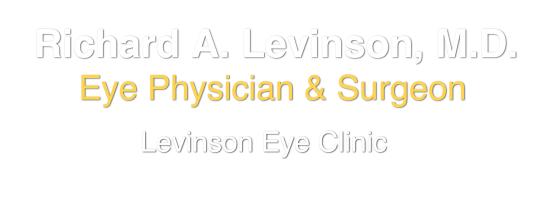
LASIK and PRK Facts
It’s Important to Know
Click title to read details…
Should I choose LASIK or PRK?
Both LASIK and PRK give excellent results. Both use an Excimer Laser to reshape your cornea. With LASIK a thin flap of corneal tissue is lifted and the laser correction placed on the underlying corneal bed and the overlying corneal flap then repositioned.
With PRK the correction is placed on the surface of the cornea. However, the surface of the cornea is covered by a thin layer of clear skin, called epithelium, that if lasered, would grow back and the laser effect negated. In PRK, but not LASIK, we have to remove this layer of epithelium prior to performing the Laser. Removing the epithelium is painless. However, after PRK there is discomfort until the epithelium heals, which usually takes about 3 days. I put an extended-wear soft contact lens on your eye after PRK, which stays in for 4-5 days after PRK, to allow the epithelium to heal faster. In both PRK and LASIK, I have you use antibiotic drops to prevent infection and anti-inflammatory eye drops to decrease discomfort.
I recommend PRK for younger, active patients, for patients with thin corneas, for patients with allergies who may vigorously rub their eyes, and for patients with higher myopic (nearsighted) prescriptions over -5.00 diopters. Presently, I am performing approximately 60% PRK and 40% LASIK.
If the thought of the flap in LASIK makes you uncomfortable, I would strongly encourage you to consider PRK! PRK is slightly safer and slightly more predictable than LASIK. Also, in my experience, I think the quality of vision is slightly better long term with PRK. The risk associated with the LASIK flap is small, but in 1-2% of LASIK patients, flap complications occur, but are usually treatable without resultant vision loss. PRK is more uncomfortable (usually watering, light-sensitivity, gritty sensation) than LASIK for 48-72 hours post-op.
I think the biggest drawback to PRK is that the vision takes longer to clear after PRK than LASIK. LASIK patients typically return to normal activities 1-2 days after surgery; PRK patients are typically blurrier than LASIK patients for about a week after surgery but can usually return to work within 5 days after surgery. Typically, 7-10 days after PRK, patients are seeing well enough to function without problem, and by 4-6 weeks the vision after PRK is usually excellent. PRK has a lower retreatment rate (1-2% vs 5-10% for LASIK) and may have somewhat less glare and dryness than LASIK. I prefer LASIK in hyperopic (farsighted) patients. Once again, both LASIK and PRK give excellent long term results; PRK is slightly safer than LASIK but is more uncomfortable initially and takes longer to heal.
What makes me a good candidate for Laser Vision Correction?
Over 95% of people that wear glasses or contacts are candidates for Laser Vision Correction. According to the FDA, you must be at least 18 years old and your glasses or contact lens prescription must be stable for at least 1 year. Stability is defined as a change of .5 diopter or less in your prescription over the last year. You cannot be pregnant or nursing; you cannot have collagen vascular disease. You cannot be taking Accutane or Cordarone (Amiodarone). Assuming your corneas are thick enough, I can treat up to about -14 diopters of nearsightedness, +6 diopters of farsightedness and 6 diopters of astigmatism.
I need to measure your corneal thickness to determine if you have enough corneal tissue available to be safely treated with Laser Vision Correction. Also, you will need corneal topography (a topographical “picture” of your eye) to make sure you do not have corneal irregularities that will prevent you from having a good result. We will do all these tests at your free consultation. If you are 18 or over, have stable vision, and your corneas are thick enough and have no evidence of structural weakness, you are a candidate.
I presently wear contact lenses. How far in advance do I need to stop wearing them?
Contact lenses invariably cause at least minimal corneal distortion. This distortion must resolve before your cornea is Lasered. If it has not resolved, your final visual outcome will not be accurate. Soft lens wearers must stop wearing their lenses 14 days prior to their preoperative appointment, and hard or gas-permeable lens wearers must stop wearing their lenses 3 weeks prior to their preoperative appointment. Occasionally, if the distortion persists, the patient will require longer periods without their contacts before having the procedure.
I have dry eyes. Is it safe for me to LASIK or PRK?
After LASIK, patients often experience dry eyes, requiring the use of moisture drops to keep the eyes comfortable. The dryness symptoms usually resolve after 3-6 months. Many patients on whom I perform LASIK have preexisting dry eyes. In fact, most of the patients who have LASIK have decided to have LASIK because they can no longer comfortably wear their contact lenses, and this is usually due to dryness. So dryness is usually not a contraindication for LASIK. However, if you have very dry eyes and are unable to get relief with artificial tears or punctal plugs, or if when I examine your eyes, I see evidence of dryness-induced abnormalities on your cornea, I would not recommend LASIK. In patients with very dry eyes, I would consider PRK instead of LASIK because dryness is less significant with PRK than LASIK.
I’ve was told by my “eye doctor” that I am not a candidate for Laser Vision Correction. Do I have any other options?
Obviously, not all patients are candidates for Laser Vision Correction. However, if you were told that you are not a candidate for Laser Vision Correction, I would encourage you to get a second opinion. In my experience, eye doctors that do not perform Laser Vision Correction do not always have enough experience to determine if you are a good candidate for Laser Vision Correction. Also, they may not be aware of all the options available to potential Laser Vision Correction patients.
Eye doctors without extensive experience in performing Laser Vision Correction tend to be extremely conservative and can tell patients they are not a candidate for Laser Vision Correction when, in fact, they are good candidates. I am not claiming that I can perform Laser Vision Correction on every interested patient, but I am stating that I have safely and successfully performed Laser Vision on patients who had been told by a previous “eye doctor” that they were not candidates for Laser Vision Correction. I invite you to call my office (303-393-0347) and schedule a free consultation to determine if you are a candidate for Laser Vision Correction. If you are not a good candidate for Laser Vision Correction, you do have two other surgical options: a Clear Lens Extraction (CLE) and an Intraocular Contact Lens (ICL).
A Clear Lens Extraction involves removing the lens of the eye and replacing it with an artificial lens, called an intraocular lens (IOL), that corrects the refracted error. This is actually cataract surgery in a patient that doesn’t have a cataract. CLE works very well in correcting extreme amounts of Nearsightedness, Farsightedness and Astigmatism. CLE costs about $3500 per eye. The IOL does not replace the dynamic range of focusing for near that patients under age 40 have so we don’t typically do a CLE in patients under 40. For patients under 40, we can perform an Intraocular Contact Lens (ICL).
An ICL is a thin artificial lens that is placed inside the eye, just in front the natural lens of the eye. In the above described Clear Lens Extraction, the natural lens of the eye is removed and replaced with a new intraocular lens (IOL). With the ICL the natural lens of the eye is left in place. This allows for the continued dynamic range of focusing in the under 40 year old eye. ICL’s only correct extreme amounts of Nearsightedness. They do not correct Astigmatism, but Laser Vision Correction can be performed after the ICL to correct the Astigmatism. ICL’s are in the $3500 per eye range. The ICL is removable although it may be associated with complications that are not reversible, such as causing cataracts.
I perform Clear Lens Extractions (CLE), but I do not perform ICL surgery because the vast majority of patients I see can be safely treated with Laser Vision Correction, which is a safer and less invasive, and less costly, procedure. ICL surgery is a miniscule fraction of the Refractive Surgery Procedure population, and I don’t feel I could do enough ICL surgery for me to be proficient. If a patient is a good candidate for an ICL, I refer them to Dr. Stark Johnson or Dr. Stuart Lewis. They are both excellent surgeons in the Denver area that are experienced in performing ICL surgery.
If I have a history of significant scar formation from other surgical procedures, will I get scarring from LASIK or PRK?
Very faint scarring may be present after the procedure. This cannot be seen except under a microscope and is not usually visually significant. The cornea heals completely differently than the rest of the body. There is no blood released in Laser Vision Correction, so there are no platelets, clots, or fibroblasts to cause scar formation.
What does the FDA say about LASIK?
In 2009, at the urging of a small but vocal group of dissatisfied LASIK patients, the FDA agreed to investigate the safety and rate of occurrence of LASIK, not PRK, complications. Over 700,000 FDA-approved LASIK procedures are performed annually in the United States. LASIK, when performed correctly on properly evaluated LASIK candidates, by an experienced LASIK Surgeon, using properly maintained state-of-the-art equipment, is an extremely safe and satisfying procedure, but there are LASIK risks, which, fortunately are not common.
However, if LASIK is not performed meticulously on properly screened candidates, the incidence of complications will increase. Understandably, LASIK patients that are dissatisfied with their outcome are disappointed, angry and vocal. I appreciate the FDA’s concern in investigating LASIK complaints and helping identify sources of potential, or real problems with LASIK. In my opinion, the “problem” with LASIK is not the procedure itself when performed meticulously. The “problem” with LASIK is the potential for complications when LASIK is not performed meticulously. When LASIK is performed in LASIK “clinics” whose primary goal is to perform as many procedures as possible without the highest concern for quality, in a careless, sloppy environment without proper MD medical supervision, the procedure becomes much riskier. This is the area that, I think, needs FDA scrutiny.
As a testimony to the safety of LASIK, after extensive evaluation by the US Navy, LASIK has been, and is presently being, successfully performed on US Navy fighter pilots. The Navy has spent millions of dollars training each of these pilots and is entrusting these pilots to land $100+ million dollar planes on billions dollars aircraft carriers, at night, in inclement weather, in the middle of the ocean! This is testimony to the efficacy of properly performed LASIK. For further information, I would like to refer you to the FDA LASIK Web Site: https://www.fda.gov/medicaldevices/productsandmedicalprocedures/surgeryandlifesupport/lasik/
All the lasers I use for LASIK and PRK are FDA approved.
Should I wait until I’m done having children before I get Laser Vision Correction?
No. Becoming pregnant will not alter your vision long term after you’ve had Laser Vision Correction. Pregnancy may transiently effect your vision, especially during the last few weeks of pregnancy, but after delivery your vision will return to its pre-pregnancy level. However, you cannot have Laser Vision Correction WHILE you are pregnant! You should wait 3 months after delivering to have LASIK or PRK. If you are nursing, you should wait until your vision has stabilized to your pre-pregnancy prescription.
I’ve heard that PRK is an old, “archaic” procedure and I shouldn’t have it done.
PRK is old and “archaic” only to the extent that it has been performed since 1985, but it is still being performed safely today. Unfortunately, PRK (Photorefractive keratectomy) is often confused with RK (Radial Keratotomy). RK is an old, “archaic”, obsolete procedure performed in the 1980’s and it is not performed today. In RK, radial cuts were made with a diamond blade in the cornea to treat nearsightedness and astigmatism.
PRK uses a laser to reshape the cornea to correct nearsightedness, astigmatism and farsightedness. PRK is becoming increasingly popular because it is safer and slightly more accurate than LASIK. In 2005, 15% of Laser Vision Procedures in the US were PRK. Presently, approximately 30% of Laser Vision procedures in the US are PRK. I would expect this long-term upward trend towards PRK to continue because PRK is safer and more predictable than LASIK. I am presently performing about 80% PRK and 20% LASIK.
What is epi-LASIK?
Epi-LASIK is PRK. The difference is in how the superficial layer of clear skin (epithelium) is removed from the cornea. In PRK, the epithelium is painlessly loosened with an alcohol solution then gently wiped away. In epi-lasik, a mechanical device is used to scrape the epithelium off the cornea. The unsubstantiated claim of epi-lasik is that it heals faster and is less painful than PRK. It isn’t. Epi-Lasik was briefly popular in the early 2000’s but I don’t think many eye surgeons are performing it today because it has no advantage over PRK.
The Facts
Will Open your Eyes
Which is Better - LASIK or PRK?

Presently, I am performing approximately 60% PRK and 40% LASIK.
Also, in my experience, I think the quality of vision is slightly better long term with PRK.
The Fine Art of Vision Care

